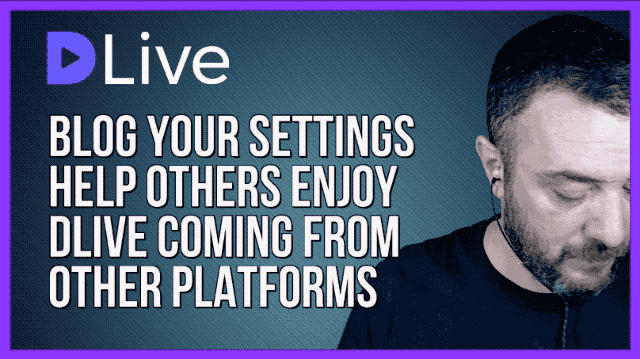one of the hardest things about live streaming is getting a decent stable internet connection to be able to stream from your computer to the host server in this instance we are talking about the dlive servers (which run I believe a wowza backend instance) today I wanted to look at a number of things including latency, upload speed, dropped frames and more.
Having a decent upstream can be hard for many factors and it’s only when we start to deep dive these that we can truly understand what’s happening on our side, what can happen and how we can try and do the best we can to protect ourselves and our connection to the host server (apart from the obvious ddos attacks on servers etc that is) — remember these things take a lot of time and energy for server hosts to maintain.
most of the time you need to well tuned things to do a good stream — a great upload and a cpu that can encode the stream without stressing it out and dropping frames, the less ‘chatter’ on your local network the better, the less applications that are doing updates the better, if you can you want to do as much as you can to optimise every step of the route between yours and the host server.
COMPUTER - less chatty task bar apps, don’t open dodgy links, low cpu
ENCODE - cpu should not drop frames, better gfx cards help
UPSTREAM - wired ethernet, solid upstream, maybe a vpn connection
Ideally I’d love to be using 5000kps and 60fps settings to stream to the @dlive server but I don’t think I’ve got the upstream reliability or CPU power to really be encoding 60 frames per second, as much as that would look crispy and smooth I think it’s going to be something that I iterate over time, that being said we might be able to do something with restream.io and I’ll look into that as I upgrade my machines to have two dedicated machines.
start to understand latency
Latency simply put is the time it takes to take a trip between one place and another on the web, think of it like getting on a bus and going at a certain speed to another place and the amount of time it takes to get back from there however this bus takes milliseconds.
Having a low ping (under <50ms) is preferred especially when you are talking to the net for something say like gaming, the lower the ping, the lower the latency of sending and returning information, if that ping is high you have a long time for the information to go and return.
When you have that situation you can have a lot of potential issues that happen because the routing of that information has more potential for the packets of information to go missing or cause stuttering or ‘latency’ issues — when it comes to live streaming you need more of a solid upstream then down because you are pushing to a server on the web than is then redistributing that feed to everyone else.
but that’s not the end of the story even if you have a good ping and latency, the server can still have issues on it’s end so even if you are sending great and the connection is good you can still ‘drop frames’ if the server end is having difficult with CPU load, ddos attacks or some other networking traffic related issue, a server and it’s connections can only handle so much before it starts to drop information because it’s overloaded — all parts need to be working effectively to give a good result.
upload speeds and what can effect it
Video streams like consistency of an upload, they don’t like ‘network traffic’ that is dips across your home network that effect the ability to constantly be sending data out to the backend server at your live stream host (in this case we are talking about @dlive) — lots of things can effect the upload speed, a few of the things to be aware of.
- do an ‘audit’ of what’s on your network, is your SSID hidden, do you have Netflix running, do you have other computers in sleep mode or systems that have tray bar apps sitting idle potentially ‘calling home’ for updates?
- do you have your mobile phone on the network? Is that download updates in the background, did you deny some apps to do background refresh or not, is it grabbing updates from the App Store?
- are you wired or wireless? You’ll have a much smoother time on wireless, maybe also consider new ethernet cables and a modern up to date router, when was the last time you checked for a firmware update?
- are their planned outages or downtime for updates in your area? Do you have the capability of a ‘failover’ in your router to a backup connection like 4g, do you have the ability to bond together connections?
- if you are using a gaming VPN do they time out after a while, will they drop the connection if activity falls below a certain point, always research what other people are using as a connection to the web.
dropped frames, cpu says no!
it can happen on your machine and on the server end — let’s focus on your machine seeing as that is the one that you have control over.
Drop frames can happen for many reasons but the core ones I’ve listed below and these should make a decent framework for things to investigate when you start to see the green block changing colour to amber or red, if you are getting them straight away when streaming your bitrate might be too high or your computer simply cannot encode the video frames fast enough to send them out (or the upload connection is not suitable)
- check what your CPU level is, you want this in the lower 50/60% of your overall machine, if you are gaming and streaming on same box this could be a problem.
- do a speedtest.net (you should do this every time you stream, reboot ya router before a stream) and check your upload, if that’s less then a few megabits you might run into some problems.
- try adjusting your bitrate encoding until you have a solid green light, it might suck on the live stream but at least you can test what’s good on the connection and cpu that you have.
- time for that upgrade? It just might be that if you have a machine over five years old that your machine is not really capable or setup for live streaming, you need a good CPU, ideally hardware (gfx/gpu) graphics card encoding and a good connection to the web.
conclusion
I hope this helped you in some way to work around any problems you might be finding with live streaming to the web (and @dlive) and I hope it inspires you to SHARE your settings, what machine you are running, what you have changed to make things better, what software, what hardware and anything else that has made your daily streaming easier.

 |  |  |  |
|---|



pinterest epic wins pinboard → brand advocate for nokia, 1000heads, verisign → won vloggie for node666 (san fran 2006) → television for time team history hunters 1999 (burton on trent) → sold me.dm to evan williams in april 2011 → went to phil campbell, alabama to help raise money after tornado ripped up the town (was on sky news, bbc news)→ CNN for sxsw 2013 about austin south by southwest event → video chat with robert scoble from rackspace → music video can you spot me? → won the digital derry contest for 5k euros → crowdfunded digital signage concept called pi street → now living life through digital blockchains.






My video is at DLive

